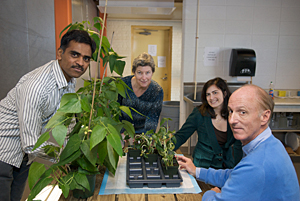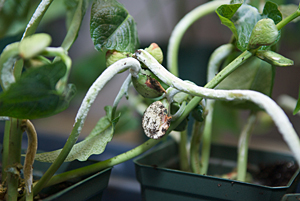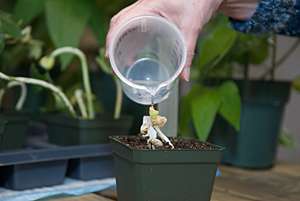

ADVERTISEMENT
- Rozovsky wins prestigious NSF Early Career Award
- UD students meet alumni, experience 'closing bell' at NYSE
- Newark Police seek assistance in identifying suspects in robbery
- Rivlin says bipartisan budget action, stronger budget rules key to reversing debt
- Stink bugs shouldn't pose problem until late summer
- Gao to honor Placido Domingo in Washington performance
- Adopt-A-Highway project keeps Lewes road clean
- WVUD's Radiothon fundraiser runs April 1-10
- W.D. Snodgrass Symposium to honor Pulitzer winner
- New guide helps cancer patients manage symptoms
- UD in the News, March 25, 2011
- For the Record, March 25, 2011
- Public opinion expert discusses world views of U.S. in Global Agenda series
- Congressional delegation, dean laud Center for Community Research and Service program
- Center for Political Communication sets symposium on politics, entertainment
- Students work to raise funds, awareness of domestic violence
- Equestrian team wins regional championship in Western riding
- Markell, Harker stress importance of agriculture to Delaware's economy
- Carol A. Ammon MBA Case Competition winners announced
- Prof presents blood-clotting studies at Gordon Research Conference
- Sexual Assault Awareness Month events, programs announced
- Stay connected with Sea Grant, CEOE e-newsletter
- A message to UD regarding the tragedy in Japan
- More News >>
- March 31-May 14: REP stages Neil Simon's 'The Good Doctor'
- April 2: Newark plans annual 'wine and dine'
- April 5: Expert perspective on U.S. health care
- April 5: Comedian Ace Guillen to visit Scrounge
- April 6, May 4: School of Nursing sponsors research lecture series
- April 6-May 4: Confucius Institute presents Chinese Film Series on Wednesdays
- April 6: IPCC's Pachauri to discuss sustainable development in DENIN Dialogue Series
- April 7: 'WVUDstock' radiothon concert announced
- April 8: English Language Institute presents 'Arts in Translation'
- April 9: Green and Healthy Living Expo planned at The Bob
- April 9: Center for Political Communication to host Onion editor
- April 10: Alumni Easter Egg-stravaganza planned
- April 11: CDS session to focus on visual assistive technologies
- April 12: T.J. Stiles to speak at UDLA annual dinner
- April 15, 16: Annual UD push lawnmower tune-up scheduled
- April 15, 16: Master Players series presents iMusic 4, China Magpie
- April 15, 16: Delaware Symphony, UD chorus to perform Mahler work
- April 18: Former NFL Coach Bill Cowher featured in UD Speaks
- April 21-24: Sesame Street Live brings Elmo and friends to The Bob
- April 30: Save the date for Ag Day 2011 at UD
- April 30: Symposium to consider 'Frontiers at the Chemistry-Biology Interface'
- April 30-May 1: Relay for Life set at Delaware Field House
- May 4: Delaware Membrane Protein Symposium announced
- May 5: Northwestern University's Leon Keer to deliver Kerr lecture
- May 7: Women's volleyball team to host second annual Spring Fling
- Through May 3: SPPA announces speakers for 10th annual lecture series
- Through May 4: Global Agenda sees U.S. through others' eyes; World Bank president to speak
- Through May 4: 'Research on Race, Ethnicity, Culture' topic of series
- Through May 9: Black American Studies announces lecture series
- Through May 11: 'Challenges in Jewish Culture' lecture series announced
- Through May 11: Area Studies research featured in speaker series
- Through June 5: 'Andy Warhol: Behind the Camera' on view in Old College Gallery
- Through July 15: 'Bodyscapes' on view at Mechanical Hall Gallery
- More What's Happening >>
- UD calendar >>
- Middle States evaluation team on campus April 5
- Phipps named HR Liaison of the Quarter
- Senior wins iPad for participating in assessment study
- April 19: Procurement Services schedules information sessions
- UD Bookstore announces spring break hours
- HealthyU Wellness Program encourages employees to 'Step into Spring'
- April 8-29: Faculty roundtable series considers student engagement
- GRE is changing; learn more at April 15 info session
- April 30: UD Evening with Blue Rocks set for employees
- Morris Library to be open 24/7 during final exams
- More Campus FYI >>
11:11 a.m., Jan. 28, 2011----When battling downy mildew, a potentially devastating disease that strikes lima beans (Phaseolus lunatus), one of Delaware's most important vegetable crops, assembling a team of experts to attack the problem from all angles is a must. That's why a diverse group of plant scientists in the University of Delaware's College of Agriculture and Natural Resources has joined together to battle this important plant disease.
Tom Evans, professor of plant pathology in the Department of Plant and Soil Sciences, and many graduate students have studied downy mildew over the past 15 years.
Evans said lima beans are vital to agriculture in Delaware and are “the cornerstone of the state's processing vegetable industry.” Approximately 6,000 hectares of baby lima beans are grown annually, with a farm value of over $6 million. If lima bean cannot be grown profitably in the state, then many other processing vegetables would not be grown due to the economics of processing.
Downy mildew, caused by the fungus-like organism Phytophthora phaseoli, is prevalent in Delaware because it thrives in humid conditions, and lima beans are grown on small, dense acreage. Evans said that most lima bean growers are concentrated in close proximity from Dover to Georgetown and from the Delaware Bay west into Maryland, so wind-driven rain makes it easier for the pathogen's sporangia to move from one lima bean field to another.
That was the case in 2000, when downy mildew caused $3 million damage in what Evans called “the largest downy mildew of lima bean epidemic ever recorded.” Two factors contributing to this epidemic were the emergence of a new race of the pathogen, Race F, which overcame the genetic resistance of lima cultivars being grown, and frequent wind-driven rain that spread the pathogen's sporangia.
With the emergence of Race F, growers could no longer rely on downy mildew resistant lima bean cultivars to prevent the disease, as they had in the past. New cultivars with resistance to Race F need to be developed and in the meantime growers have relied upon fungicides to manage the disease.
Bob Mulrooney, extension specialist in plant pathology, has tested fungicides for effectiveness against downy mildew for a number of years and has identified new more environmentally-friendly chemicals which offer good control. Mulrooney's research results are the basis for growers' current downy mildew management practices.
Evans and his group have been responsible for studying the biology of the pathogen, monitoring the evolution of new races of the pathogen and the epidemiology of the disease.
Extension associate Nancy Gregory diagnoses the disease on samples sent in by growers, maintains the pathogen in culture for field and greenhouse experiments, and determines their races.
Emmalea Ernest, an extension associate at the Carvel Research and Education Center in Georgetown, Del., breeds lima bean for desirable traits, such as disease and drought resistance, and is developing cultivars for Delaware farmers. Ernest and Evans work together screening lima bean germplasm from around the world for resistance to races E and F of P. phaseoli. Ernest has conducted experiments to determine how the resistance genes are inherited. After making crosses between resistant parents followed by several years of field screening, Evans and Ernest are testing lima bean lines with resistance to both races this summer.
Nicole Donofrio, assistant professor of plant and soil sciences, is responsible for the pathogen side of the study, trying to understand the pathogen's virulence mechanisms, and how it evolves to attack certain aspects of the plant. Donofrio said, “In order to fight the disease, you have to know your enemy, and the more you know your enemy, the more equipped you are to tackle it when things like a new race emerge.”
Knowing exactly how to fight against the disease from a pathogen standpoint is difficult. Donofrio points out that P. phaseoli has over 500 effector genes, molecules that bind to a protein altering its activity and enabling infection. To study effectors, Donofrio and doctoral student Sridhara Kunjeti took a two-pronged approach. First, they took what they knew about P. infestans, the pathogen responsible for the Irish potato famine and a close relative of P. phaseoli, and searched for similar genes in P. phaseoli to determine if it used similar mechanisms in its attack on lima bean.
Next, they looked at lima beans that had been infected for three and six days to see which effectors were active during those time-points of infection. Donofrio said this could lead to a breakthrough because if they are able to characterize the effector genes, they can look for traits that could be a countermeasure to pathogen attack and thereby block pathogenesis.
Randy Wisser, assistant professor of plant and soil sciences, works on aspects of quantitative genetics and plant breeding and Blake Meyers, Edward F. and Elizabeth Goodman Rosenberg Professor and chair of the Department of Plant and Soil Sciences, works on genomics of lima bean-downy mildew interactions.
In various combinations, the research team has received over $200,000 from various CANR seed grants and Delaware state grants to more fully explore P. phaseoli and downy mildew.
Article by Adam Thomas
Photos by Danielle Quigley



